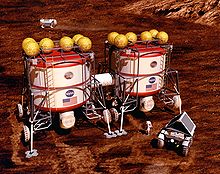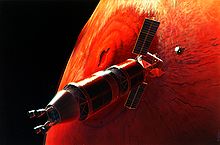NASA Design Reference Mission 3.0: Difference between revisions
Clean up image descriptions...way too detailed. |
Additional image name fixes. |
||
| Line 1: | Line 1: | ||
{{cleanup|date=April 2008}} |
{{cleanup|date=April 2008}} |
||
[[File:Mars design reference mission 3 |
[[File:Mars design reference mission 3.jpg|thumb|Artist concept of a Mars habitat]] |
||
[[File:ReferenceMissionSequenceVersion3.0.gif|thumb|Overview of the Reference Mission Version 3.0 architecture]] |
[[File:ReferenceMissionSequenceVersion3.0.gif|thumb|Overview of the Reference Mission Version 3.0 architecture]] |
||
[[File:Mars orbit rendez vous S95 01407.jpg|thumb|Artist concept of a Mars orbit rendezvous]] |
[[File:Mars orbit rendez vous S95 01407.jpg|thumb|Artist concept of a Mars orbit rendezvous]] |
||
[[File: |
[[File:Mars In-Situ Resource UtilizationSample Return MISR.jpg|thumb|Artist concept of a Mars sample return mission]] |
||
'''NASA Design Reference Mission 3.0''' was a [[NASA]] study for a human space mission to the planet [[Mars]] in the 1990s. It was a plan for a human exploration architecture for Mars, but has since been superseded by newer NASA DRM (Including 4 and 5 in the following decade). |
'''NASA Design Reference Mission 3.0''' was a [[NASA]] study for a human space mission to the planet [[Mars]] in the 1990s. It was a plan for a human exploration architecture for Mars, but has since been superseded by newer NASA DRM (Including 4 and 5 in the following decade). |
||
Revision as of 15:45, 16 February 2010




NASA Design Reference Mission 3.0 was a NASA study for a human space mission to the planet Mars in the 1990s. It was a plan for a human exploration architecture for Mars, but has since been superseded by newer NASA DRM (Including 4 and 5 in the following decade).
The study was performed by the NASA Mars Exploration Team at the NASA's Johnson Space Center (JSC) in the 1990s. Personnel representing several NASA field centers formulated a “Reference Mission” addressing human exploration of Mars. The plan describes the first human missions to Mars with concept of operations and technologies to be used as a first cut at an architecture. The architecture for the Mars Reference Mission builds on previous work, principally on the work of the Synthesis Group (1991) and Robert Zubrin's (1991) concepts for the use of propellants derived from the Martian atmosphere. The primary purpose of the Reference Mission was to stimulate further thought and development of alternative approaches which can improve effectiveness, reduce risks, and reduce cost. Improvements can be made at several levels; for example, in the architectural, mission, and system levels.
As the report of the Reference Mission Version 3.0 states: "From the work of the original Reference Mission (Version 1.0), the strategy for the human exploration of Mars has evolved from its original form to one of reduced system mass, use of a smaller, more reasonable launch vehicle, and use of more current technology. The steps which have been taken by the Exploration Team are motivated by the need to reduce the mass of the payload delivery flights, as well as the overall mission cost, without introducing additional mission risk. By eliminating the need for a large heavy-lift launch vehicle and deleting the redundant habitat delivery flight in Version 3.0 , two launches from the Earth were eliminated. The net result is a current Version 3.0 Reference Mission which requires an injected mass of approximately one-half that of the 1993/94 Reference Mission."
See also
External links
NASA Design Reference Mission
- JSC Exploration Site
- Human Exploration of Mars: A The Reference Mission of the NASA Mars Exploration Study Team, 1997, NASA JSC Exploration Office (Mars Reference Mission - DRM 1.0)
- Addendum (Update) to Human Exploration of Mars: The Reference Mission of the NASA Mars Exploration Study Team, 1998, NASA JSC Exploration Office (Mars Reference Mission - DRM 3.0)
- A Mission Design for International Manned Mars Mission, From the 1991 International Space University (ISU) Design Project (Mendell, Wendell)
- Mars Exploration Strategies: A Reference Program and Comparison of Alternative Architectures
- NASA Report, Mars Design Reference Mission 3
- Design Reference Mission 3.0 (Astronautix)
- "Reference Mission Version 3.0 Addendum to the Human Exploration of Mars: The Reference Mission of the NASA Mars Exploration Study Team," Bret G. Drake, editor, NASA Lyndon B. Johnson Space Center
- Human Exploration of Mars: The Reference Mission of the NASA Mars Exploration Study Team
- NASA TP 2001-209371: The Mars Surface Reference Mission: A Description of Human and Robotic Surface Activities
- Stoffel, Wilhelm, and Wendell Mendell, "An Organizational Model for an International Mars Mission", From the 1991 International Space University (ISU) Design Project
- Weaver, David B., and Michael B. Duke, "Mars Exploration Strategies: A Reference Program and Comparison of Alternative Architectures, Conference Paper AIAA 93-4212, (1993)
- Weaver, David B., Michael B. Duke, and Barney B. Roberts, "Mars Exploration Strategies: A Reference Design Mission," Conference Paper IAF 93-Q.1.383, (1993)
- NASA illustrations of DRM (Source: Mars Society)
